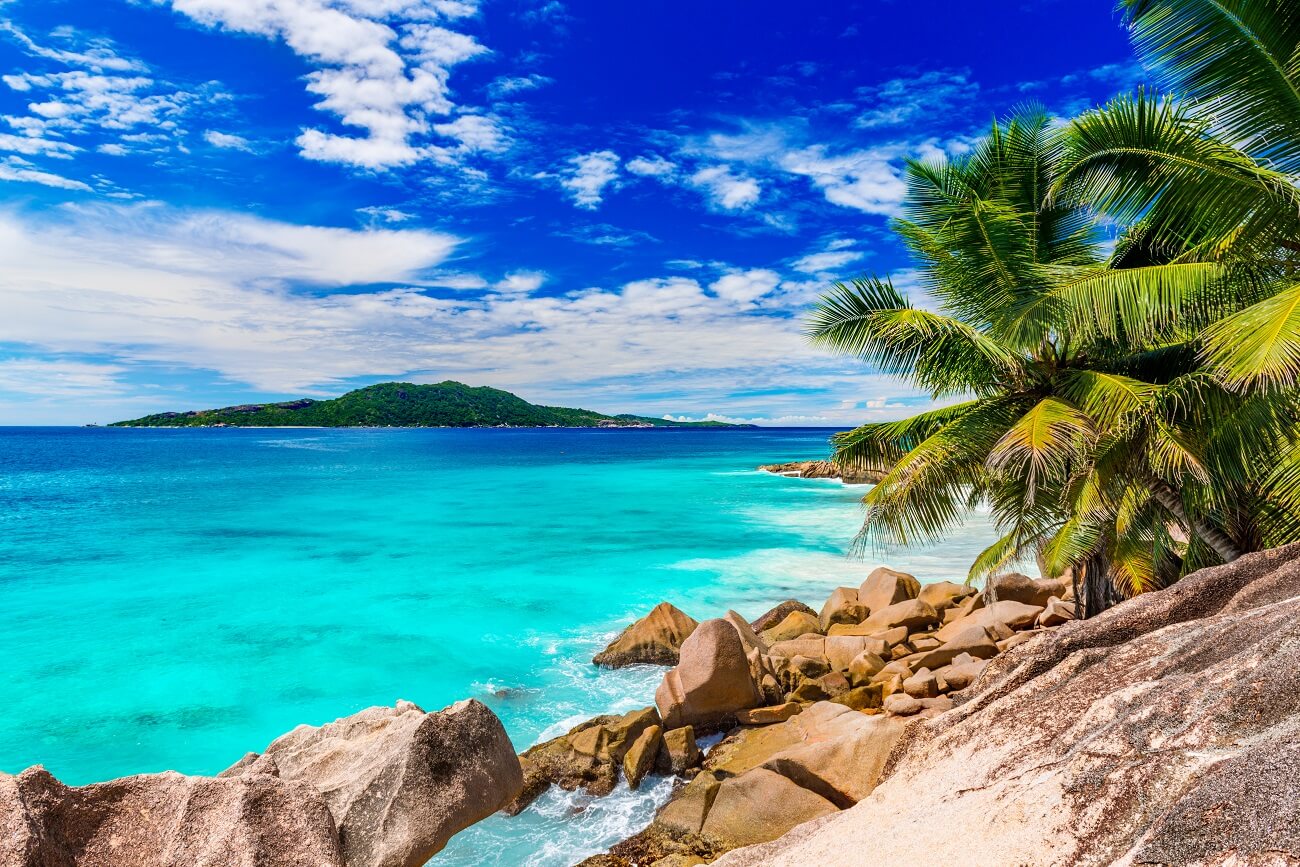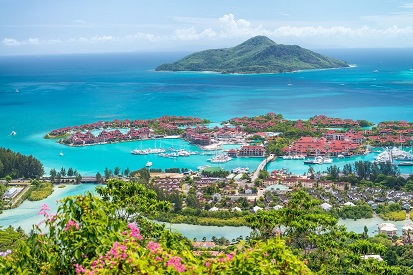

The Seychelles Islands are a remote slice of paradise that remains an undiscovered corner of the planet for many. What do you need to know before going on vacation to the Seychelles? Let's find out in this article.
Choosing the weather: when is the best time to fly to the Seychelles?
The good news right away: the Seychelles almost always has heavenly weather. Forget about winter—it simply doesn't exist here, and don't pack your warm clothes. Temperatures range from 24°C to 30°C year-round. Ideal for spending all day and night on the water! But there are some nuances. The year is roughly divided into two seasons:
- Dry season (April to October): considered the best time to visit. There's little rain, a pleasant breeze, and a calm ocean. It's perfect for snorkeling, diving, and simply relaxing.
- Wet season (October to April): This is when the weather gets hotter and more humid. The northwest monsoons can hit especially from December to March. However, the rains don't last. They typically come in short, heavy downpours, followed by the sun shining again. Nature is especially verdant during this time. It's the perfect time to explore tropical destinations!

Depositphotos
What you need to know about a visa to the Seychelles
A visa to the Seychelles is not required! However, before departure, every tourist must obtain a travel permit online. This can be done on the official website; a fee is charged. Without this permit, you simply won't be allowed on the plane. At the border, be prepared to show proof of accommodation, a return ticket, and valid travel insurance.

Depositphotos
What language is spoken in Seychelles?
There are three official languages on the islands: Creole, English, and French. All the locals speak their own, very melodious Creole. A basic understanding of English is easy to get by in restaurants, cafes, and elsewhere. Knowing a few French phrases will also come in handy and will make the locals smile.
Money: What currency is used in the Seychelles and where to exchange it?
The local currency is the Seychelles rupee (SCR). But don't rush to exchange a ton of money in advance. Firstly, you won't be able to buy this currency outside the archipelago. However, you can travel with euros and dollars, as all major hotels and establishments accept them. It's ideal to have a card that doesn't charge a commission for foreign transactions – this will help you save a significant amount.
You can easily withdraw cash on the main island of Mahé, where your plane will land, or on Praslin. These are the two largest islands, and ATMs are readily available. However, if you're heading to a small, secluded island, it's best to stock up on cash. A little life hack: in tourist areas, both dollars and euros will be accepted. However, the exchange rate will likely be unfavorable, so paying in rupees is almost always cheaper.

Depositphotos
Internet and Communications: How to Stay Online
Hotels have Wi-Fi, but its speed can be unpredictable. The best option is to buy a local SIM card right at the airport upon arrival (Cable & Wireless or Airtel). This data plan will allow you to use GPS, call a taxi, and post photos without any hassle.

Depositphotos
Food and Drink: Must-Try Items in the Seychelles
The local cuisine is a truly incredible mix of French, African, Indian, and even British influences. Forget frying—everything is baked in banana leaves, simmered in coconut milk, and marinated in spices. Fish dishes are often named after islands and beaches, so don't be surprised if you see "Anse Lazio tuna" on the menu.
Get ready for an abundance of spices – curry, ginger, chili, cinnamon, nutmeg. And be sure to enjoy the local fruits of the Seychelles: mango, papaya, passion fruit, star fruit, breadfruit – they're everywhere. Fruits are eaten fresh, used in salads, and added to sauces for fish and meat.
The freshest bounty of the ocean is the foundation of everything. Be sure to try the octopus curry, grilled fish, shark chutney, and fish soup with spinach... You'll be pleasantly surprised by the variety of the menu, even in the most basic eatery.
As for drinks, coconut water and freshly squeezed juices are everywhere. For alcoholic drinks, try kalu palm wine, bakka rum, and local beer.
Tip: Buy and drink only bottled water to avoid a vacation marred by poor health.

Depositphotos
Transportation: How to get around the Seychelles
You can either save money on getting around the islands or make transfers your main expense. Transportation in the Seychelles is very expensive. Research this in more detail.
The most cost-effective option is to stay on the main island of Mahé, where the international airport is located, where you'll fly into the Seychelles. Mahé offers a vibrant tropical travel experience and wonderful beach resorts. Praslin and La Digue are also fairly affordable destinations , accessible by ferry. The other islands, however, require a tour or private transfer, which can be quite expensive.
On Mahé, you can use a car or public transportation. Renting a car is the best way to explore the island.
Taxis in the Seychelles are expensive and, unfortunately, not always fair. Overcharging tourists is common. Uber and similar apps are nonexistent here. A 30-minute taxi ride can cost as much as renting a car for the entire day!
Tip: If you book a taxi through a hotel, clarify upfront whether you'll be paying the hotel or the driver. It's best to choose the hotel payment option.

Depositphotos
Dress code and etiquette rules
Greetings. In the Seychelles, it's customary to greet everyone, even strangers on the street. A simple nod, a smile, or a "bonjour" will be enough to make you feel welcome.
No one is in a hurry here, so don't expect everyone to be punctual. Being late is part of the local culture.
Dress code: Shorts, tank tops, and swimsuits are required during the day. In the evening, more covering clothing (light pants, dresses, or shirts) is recommended for restaurants and hotels. Topless sunbathing and nudism are strictly prohibited.
Respect nature. Seychellois adore their islands and are very protective of nature. Leaving litter on the beach or in the forest can result in a hefty fine.

Depositphotos
Safety tips for visiting the Seychelles
Valuables and documents. The Seychelles is a relatively calm and safe place. Locals are generally very friendly, and crime is rare, but it's still worth keeping an eye on your belongings on the beach. The golden rule for tourists is not to display valuables or leave them unattended. It's best to leave your passport, large sums of cash, and jewelry in the hotel safe. Carry a copy of your passport and some cash for the day.
Night walks. Seychelles nights are beautiful, but wandering along dark, deserted beaches or unlit streets alone is a bad idea. It's best to call a taxi.
Jungle treks. You'll be surrounded by exotic plants and cute creatures. The golden rule of the jungle: look, take pictures, but don't touch.
Swimming on the beaches. Seychelles beaches often have strong currents, and in some locations there are sharp reefs. There may be no warning signs or lifeguards. It's best to check with locals whether a beach is suitable for swimming before entering the water. Shark attacks in the Seychelles are extremely rare. The chances of encountering one near the shore are minimal. So swim with confidence!
Health. Dengue fever is common on the islands, so stock up on good insect repellents. As for medical care, there are hospitals here, but you may have to travel to the capital. It's important to have travel insurance that covers medical evacuation if you become ill on a private island and need to be transported to a hospital on Mahé.
Sun protection. The equatorial sun in the Seychelles is very strong. You can burn in 20 minutes, even on cloudy days. Bring sunscreen with an SPF of at least 50 and reapply it after every swim. Wear a hat and light, long-sleeved clothing, especially on excursions.
Water hazards. During low tide, when the water recedes and the bottom is exposed, be especially careful. The main "traps" are sea urchins and sharp corals. Invest in special rubber swimming shoes. You can safely enter the water anywhere with them.

Depositphotos
What not to miss in the Seychelles
The archipelago is home to many fascinating places, nature reserves, jungles, and beaches. To ensure you see all the highlights, you can focus your visit on these corners of the archipelago.
- The Vallée de Mai Nature Reserve. This is not just a park, but a true prehistoric forest, a UNESCO World Heritage Site. It's located on Praslin. It's home to giant palm trees bearing the legendary coco de mer nuts. It'll feel like you've stepped into a Jurassic Park set !
- The capital of the Seychelles, Victoria, is one of the smallest and most cozy capital cities in the world, located on the island of Mahé. Stroll through streets lined with colorful colonial houses, visit a colorful market, and snap a photo next to a miniature replica of London's Big Ben.
- The Copolia Trail on Mahé. This is an easy yet challenging hike that leads to the mountain's summit. The effort is well worth it: from there, you'll enjoy incredible panoramic views of the entire island and the ocean.
- Ste. Anne Marine Park. These are several small islands near Mahé where you can snorkel among coral reefs, swim with sea turtles, and simply relax on pristine beaches.
- Turtles. The Seychelles' main living symbol, and a must-see, are the Aldabra giant tortoises. They can weigh up to 400 kg and live up to 200 years! You can encounter them in special parks and hatcheries on Mahé. The largest population of tortoises in the wild can be seen on Curieuse Island, where day trips are available from Praslin.

Depositphotos
More articles
- Top 12 Bali Hotels for Wellness
- Top 10 Places to See in the Seychelles
- Bali hotels in the jungle: 10 most beautiful
- Hotel in Bali with breakfast included: 10 popular places
- The Best Boutique Hotels in Bali
- The best hotels in Seychelles on the coast - 10 corners
- The best resorts in Bali: where to relax on the island
- Seychelles hotels with the best restaurants
- Hotels Seychelles Adults Only
- Best luxury hotels in the Seychelles according to Forbes Travel Guide



